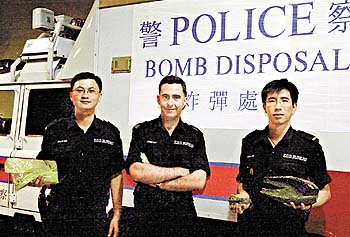EOD in delicate disposal
EOD officers Chan Kwong-hung, Alick McWhirter and Kam Chi-fai show the mortar shell and its explosive contents |
Explosive Ordnance Disposal officers disarmed a highly unstable mortar shell unearthed in a Causeway Bay demolition site, May 23.
The quick and skilful work of the EOD team, which included Bomb Disposal Officer Alick McWhirter and Police Constables Kam Chi-fai and Chan Kwong-hung, saw minimum disruption to the bustling district packed with shoppers, tourists and workers.
A 45-centimetre Japanese army mortar was loaded with TNT and a highly unstable detonator. Some 1,500 people were evacuated from nearby shops and a residential building while Hennessy Road between Percival Street and Jardine's Bazaar was closed-off for five minutes during two controlled explosions to disarm the shell.
Mr McWhirter said the scene was particularly dangerous as the mortar was only eight metres from the Causeway Bay MTR station structure and roughly the same distance from a gas pipe.
"The fuse was armed and unstable so there was a good chance it would explode. The lethal radius was as much as 50 metres so we had to deal with it in-situ," he said.
"The easier and preferred option in doing this would have simply been to blow it up. However, this would have been particularly hazardous due to the close proximity of the MTR and glass-walled buildings in the area.
"The shockwave from the blast would have been enough to kill people, shower the street in shattered glass and disrupt the MTR's services."
PC Kam said: "Instead, we used a small charge to cut open the shell, then removed the explosives and fired another small charge to blow the fuse. This way no damage was caused at all during the operation so shoppers and workers could quickly resume their errands."
PC Chan said the mortar was another in the long line of unexploded World War II ordnance being excavated at construction sites.
"It appears the mortar was fired during the Battle for Hong Kong, landed in soft ground and was left unexploded and unseen for years, eventually being built over," he said.
"There are many scenarios like this in Hong Kong and I feel we will continue to be very busy disposing of a lot more unexploded ordnance dug up on construction sites."
Senior Bomb Disposal Officer Dominic Brittain hailed the officers' work.
"Mortars are especially dangerous as they have few safety mechanisms. We have picked up similar mortars to this one in the past, but they are not hugely common. However, it was the location that made disarming this particular bomb very tricky, as we could not blow it up on site. It required an advanced level of skill and I am extremely pleased with the officers' work."
The incident highlighted EOD Bureau's heavy workload, being the second of three callouts for the duty EOD team that day. In addition, the Bureau was heavily committed on a week-long operation at Castle Peak Range where, with the assistance of EOD Cadre officers, 119 WWII shells, unearthed over the last three months, were safely destroyed.
<< Back to Index >>
